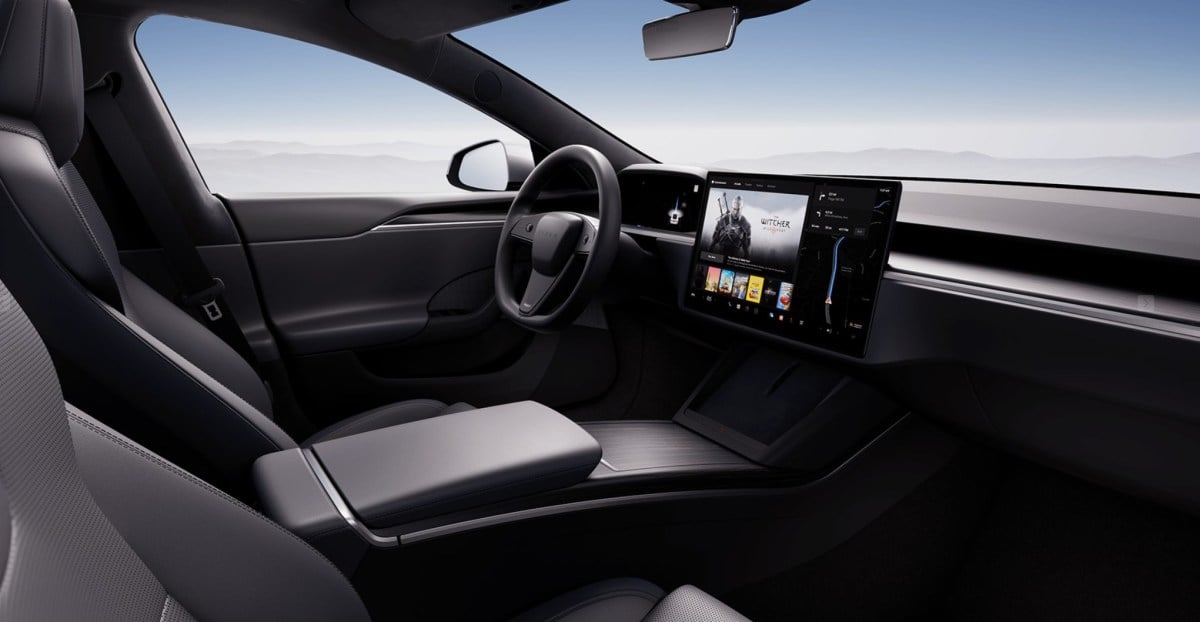Cars will need fewer screens and more buttons to earn a 5-star safety rating in Europe | Euro NCAP will introduce new testing rules in 2026 requiring physical controls for the highest safety score
-
You afraid of getting bugs in your teeth? Coward. ^/s^
The rate of decline of insects in the last few decades is quickly making that a non-issue.
-
European New Car Assessment Program (NCAP) — an independent and well-regarded safety body for the automotive industry — is set to introduce new rules in January 2026 that require the vehicles it assesses to have physical controls to receive a full five-star safety rating.
While Euro NCAP testing is voluntary, it is widely backed by several EU governments with companies like Tesla, Volvo, VW, and BMW using their five-star scores to boast about the safety of their vehicles to potential buyers.
“The overuse of touchscreens is an industry-wide problem, with almost every vehicle-maker moving key controls onto central touchscreens, obliging drivers to take their eyes off the road and raising the risk of distraction crashes,” said Matthew Avery, director of strategic development at Euro NCAP, to the Times. To be eligible for the maximum safety rating after the new testing guidelines go into effect, cars will need to use buttons, dials, or stalks for hazard warning lights, indicators, windscreen wipers, SOS calls, and the horn.
The Euro NCAP’s safety guidelines aren’t a legal requirement, however, car makers take safety ratings pretty seriously, so any risk of points being docked during such assessments is likely to be taken into consideration.
More physical controls is great, so I see this as a win. For navigation and media, I don't want to be without the screen, but I hate that my ventilation controls are 50 % hidden under touch controls, meaning I usually don't bother to change them while I drive, because it requires looking away too much.
-
Before anyone forgets, this all started with Tesla. They lacked the skill, talent, know how, money and manufacturing capacity to make a decent center console. They then decided to move everything to the touchscreen because software is cheap to add to cars, thousands of small precision engineered objects are not. It was a margins game by the man "with the most knowledge on manufacturing in the world". The rest of the industry followed because the bougie idiots made the band popular so the competitors just copied that absolutely regarded idea.
Everyone calling this regarded was screamed into oblivion by tesla fanboys and design savants: "You're just too dumb to understand minimalist design".
And here we are, turns out designing something that makes the driver take their eyes off the road on a 2000Kg murder machine is actually NOT good design.Queue
Cue
-
It served humanity just fine for decades. My car is 25 years old and never ran anything over. Look before you get in, check your mirrors, crane your neck, look over your shoulder, activate parts of your brain. I plan on never owning one of these over complicated modern cars. You do you though I guess.
My car is 25 years old and never ran anything over.
That's in part because your car is 25 years old. Designs have changed over time to increase the sizes of blind spots (as an unintended consequence of things like strengthening the support pillars for the roof to increase rollover survivability).
-
Lol of course not, but it's assembled somewhere which is why it has a cost more than the simple cost of the button itself. It's a bespoke piece of hardware specifically designed for the vehicle instead of a commodity LCD screen which can be mass produced for multiple vehicles.
It is not as if buttons required in cars differ wildly between models, they could easily mass produce those too if they wanted to and if cost is such a major concern maybe getting rid of the stupid design team that makes them look different for every model would save a lot more money.
-
The mandatory in EU reversing camera.
-
Also it accelerates the design-to-manufacture cycle of a new model - just slap a huge touch screen on it and start building the car, and hope the software is ready in time. If not, well, just ship it as is and patch it later.
Builds in a very expensive replacement component too.
A control button breaks? New button is a (still over-inflated) $75 to replace.
A Tesla control screen breaks (and they do, just as often as buttons) - $1500.
https://www.greencarfuture.com/electric/tesla-screen-replacement-cost-process#Cost
-
It served humanity just fine for decades. My car is 25 years old and never ran anything over. Look before you get in, check your mirrors, crane your neck, look over your shoulder, activate parts of your brain. I plan on never owning one of these over complicated modern cars. You do you though I guess.
Yea and sweetening wine with lead never hurt anyone, the Romans turned out fine!
-
People do that on purpose, there’s a huge aftermarket for 10x brighter headlights.
New models have LED headlights and they're awful. They're angled down, but any sort of hilly back road means you're blinding anyone in front of you anyway. Halogen are much better because it's a softer glow instead of a laser beam.
-
I’m actually a fan of big screens, HOWEVER they should be limited to being an actual “infotainment” system only. All essential controls should be buttons, switches, and dials.
One thing I really like about the Lucid Air is that the big screen retracts. Makes it look and feel quite different, almost like an older car without the big screen.
Important controls like seats, temperature, and volume/pause are physical. So you can have the big screen when you want it, and it goes away when you don’t. More cars should do that, though the additional moving part probably isn’t great for longevity.
-
European New Car Assessment Program (NCAP) — an independent and well-regarded safety body for the automotive industry — is set to introduce new rules in January 2026 that require the vehicles it assesses to have physical controls to receive a full five-star safety rating.
While Euro NCAP testing is voluntary, it is widely backed by several EU governments with companies like Tesla, Volvo, VW, and BMW using their five-star scores to boast about the safety of their vehicles to potential buyers.
“The overuse of touchscreens is an industry-wide problem, with almost every vehicle-maker moving key controls onto central touchscreens, obliging drivers to take their eyes off the road and raising the risk of distraction crashes,” said Matthew Avery, director of strategic development at Euro NCAP, to the Times. To be eligible for the maximum safety rating after the new testing guidelines go into effect, cars will need to use buttons, dials, or stalks for hazard warning lights, indicators, windscreen wipers, SOS calls, and the horn.
The Euro NCAP’s safety guidelines aren’t a legal requirement, however, car makers take safety ratings pretty seriously, so any risk of points being docked during such assessments is likely to be taken into consideration.
I think Euro NCAP ratings would have more teeth if it was mandatory for manufacturers of standard passenger vehicles to submit a reference model for testing. Voluntary testing doesn't work since manufacturers would be averse to submit cars for testing if they thought they'd get a bad score. And while Euro NCAP does sometimes buy cars for testing, they don't do it for every make and model.
And if the cheapest dogshit cars on the road (Kia Picantos, Dacia Sandero's etc) can have buttons, dials, wipers and indicators then so should everything above it. Companies like Tesla remove controls to cheap out on having to make a part, but they attempt to pass this off as innovation when it puts people's lives at risk.
-
Before anyone forgets, this all started with Tesla. They lacked the skill, talent, know how, money and manufacturing capacity to make a decent center console. They then decided to move everything to the touchscreen because software is cheap to add to cars, thousands of small precision engineered objects are not. It was a margins game by the man "with the most knowledge on manufacturing in the world". The rest of the industry followed because the bougie idiots made the band popular so the competitors just copied that absolutely regarded idea.
Everyone calling this regarded was screamed into oblivion by tesla fanboys and design savants: "You're just too dumb to understand minimalist design".
And here we are, turns out designing something that makes the driver take their eyes off the road on a 2000Kg murder machine is actually NOT good design.Tesla doesn't have that excuse. The original Roadster, Model S and Model X all had fairly conventional controls. They deliberately undermined the safety of their vehicles by aggressively removing physical controls with the model 3 and Y. It probably saved them a few bucks, but at the cost increased risk to human life. If they get penalized in safety tests for their penny pinching then so be it.
-
While we're at it get rid of retina frying headlights. Sure, you can see great but I'm blind as I drive into you at night. At least make it so they don't look like point sources and can't aim upwards.
Also make the auto headlight setting the default if the car is in drive. Too many people driving in the twilight with no headlights on.
If you're in the US like me, we should be aware the problem isn't bright lights; it's that our regulations don't allow for the European beam alteration tech that will dim sections at a time based on oncoming traffic.
Brighter lights are a huge boon to safety, but we need the corresponding tech to keep it that way.
-
It is not as if buttons required in cars differ wildly between models, they could easily mass produce those too if they wanted to and if cost is such a major concern maybe getting rid of the stupid design team that makes them look different for every model would save a lot more money.
That would definitely help save on costs on a lot of fronts but I'm sure you'd get people complaining about the cars lacking their own style/differentiation and everything being the same if they did that. It'd think it would still be cheaper for a screen though.
But doing that is how you save money yes. Same dashes between cars, seats, heat pumps etc. as many same parts as you can between as many models as you can with as few custom parts as you can, while still making a car people want to buy that differentiates itself enough.
-
Good.
Next please go after the animated indicator lights that take way too much time to realise the car in front of you is turning and not playing snake. Fuck you, Audi, and all the others tha copied this absolute bullshit of an idea.
are animated lights cool? debatable. in my opinion, kinda.
are animated lights practical? no. I actually think they're more of a distraction. I need several use cases of where animated lights other than at car start up play an actual useful role in operating the vehicle.
car companies are going away from the practical and into the cool factor and I don't think it's a good thing. those huge car fins on caddys looked cool but provided absolutely no practical functionality (I even believe that studies showed it made them less safe. disclosure: I'm pulling this out of my rear end but I think it's true).
-
If you're in the US like me, we should be aware the problem isn't bright lights; it's that our regulations don't allow for the European beam alteration tech that will dim sections at a time based on oncoming traffic.
Brighter lights are a huge boon to safety, but we need the corresponding tech to keep it that way.
and good luck getting those regs passed with this congress and this administration. it's likely never going to happen unless the auto industry demands them.
-
The mandatory in EU reversing camera.
-
The United States, Canada, and Japan have the requirement, too. Australia's takes effect in November 2025.
-
System shared this topic on



